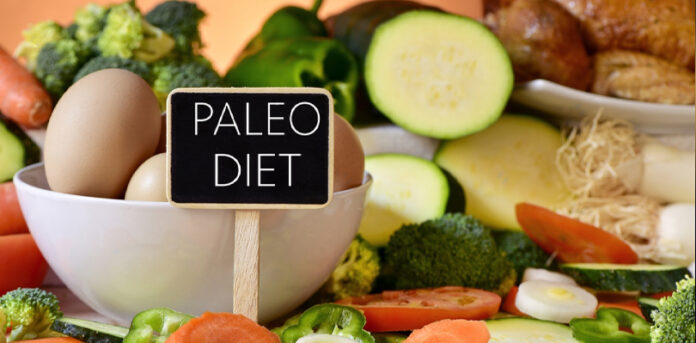The Paleo diet, also known as the “caveman diet,” is a popular diet plan. That is based on the idea of consuming foods that were available to our prehistoric ancestors. The diet emphasizes whole, nutrient-dense foods such as fruits, vegetables, lean protein sources, and healthy fats . While avoiding processed foods, added sugars, and refined vegetable oils. In this blog post, we will discuss the tips and benefits of the Paleo Diet.
A Paleo eating plan that’s rich in fiber, potassium, and antioxidants and low in simple carbohydrates, sodium, and sugar can be a healthy eating plan. It emphasizes local, sustainable, organic, and non-GMO foods as well as grass-fed meat options. It discourages foods that are heavily processed or contain artificial ingredients and colorings.
What Is The Paleo Diet

The Paleo diet includes foods that our prehistoric ancestors ate during the Paleolithic era. Such as lean meats, fish, nuts, vegetables, and fruits. The Paleolithic period lasted from about 2.5 million years ago to 10,000 years ago. Ending with the advent of agriculture and foods such as dairy, grains, beans, and legumes. The goal of this diet is to promote a healthy lifestyle and reduce the risk of chronic diseases. It provides the body with essential nutrients and eliminates pro-inflammatory foods. It’s also said that this diet can aid in weight loss and improve overall health.
This diet had a significant effect on body weight, waist circumference, and weight. According to a meta-analysis of 11 studies comparing a paleo diet to a control diet. It consists mainly of vegetables, whole grains, and low-fat dairy products. Index (body mass index). In the studies evaluated in the meta-analysis. Participants on average reported a weight loss of 3.52 kg, resulting in improvements in BMI and waist circumference.
Benefits Of The Paleo Diet
The benefit of Paleo is that it focuses on increasing your intake of whole foods, fruits, and vegetables. Healthy proteins and healthy fats, and reducing your consumption of processed foods, sugar, and salt. For those looking for a more balanced diet, these “guidelines” will sound familiar and generally healthy. The Paleo diet, also known as the “caveman diet,” is based on the idea of consuming foods that were available to our prehistoric ancestors. The benefits of this diet include:
- Weight Loss: The Paleo diet is high in protein and fiber, which can help you feel full and reduce overall calorie intake.
- Improved Blood Sugar Control: The diet is low in processed carbohydrates. Which can lead to better blood sugar control and reduce the risk of diabetes.
- Increased Nutrient Intake: The Paleo diet emphasizes whole, nutrient-dense foods, such as fruits, vegetables, and lean protein sources, which can help ensure adequate nutrient intake.
- Reduced Inflammation: These diets eliminate processed foods, added sugars, and refined vegetable oils, which are all pro-inflammatory.
- Improved Cardiovascular Health: The diet is low in saturated fat and high in monounsaturated and polyunsaturated fats. Which can help improve cholesterol levels and reduce the risk of heart disease.
- Better Digestion: The diet is rich in fiber which can help improve bowel regularity and reduce the risk of constipation.
- Better Satiety: Eating whole nutrient-dense foods can help you feel more satisfied and less likely to overeat.
List Of Foods You Can Eat In The Paleo Diet
Here is a list of foods that are typically included in this diet:
- Fruits: Berries, apples, oranges, pears, bananas, etc.
- Vegetables: Leafy greens, broccoli, cauliflower, carrots, bell peppers, etc.
- Lean Protein Sources: Grass-fed beef, wild-caught fish, free-range poultry, bison, venison, etc.
- Nuts And Seeds: Almonds, walnuts, macadamia nuts, pumpkin seeds, sunflower seeds, etc.
- Healthy Fats: Olive oil, coconut oil, avocado, avocado oil, etc.
- Eggs: Chicken, quail, duck, goose, etc.
- Seafood: Fish, shellfish, etc.
- Spices And Herbs: Fresh or dried herbs and spices, such as basil, oregano, cumin, etc.
- Natural Sweeteners: Honey, maple syrup, etc.
- Unsweetened Coconut-Based Products: Coconut milk, coconut cream, and coconut flakes
Please note that this list is not exhaustive and some variations of the Paleo Diet can include or exclude some of the above-listed foods.
Tips For Beginners
- Use the paleo diet as a starting point for a healthy eating plan.
- Add beans, lentils, nuts, whole grains, low-fat or nonfat dairy, or other sources of calcium such as dark leafy greens, tofu, soy milk, or almond milk.
- Choose your lean protein sources carefully, focusing on quality over quantity.
- A Paleo eating plan that’s rich in fiber, potassium, and antioxidants and low in simple carbohydrates, sodium, and sugar can be a healthy eating plan.
- It emphasizes local, sustainable, organic, and non-GMO foods as well as grass-fed meat options.
- It discourages foods that are heavily processed or contain artificial ingredients and colorings.
FAQs
What foods can I eat on the Paleo diet?
The Paleo diet emphasizes whole, nutrient-dense foods such as fruits, vegetables, lean protein sources (such as grass-fed beef, wild-caught fish, and free-range poultry), nuts and seeds, and healthy fats (such as olive oil, coconut oil, and avocado). Foods to avoid include processed foods, added sugars, refined vegetable oils, and grains.
Can I eat dairy products on the Paleo diet?
Dairy products are not included in the traditional Paleo diet because they were not available to our prehistoric ancestors. However, some variations of this diet include small amounts of full-fat dairy products such as butter, cheese, and heavy cream. It’s important to note that if you have a dairy allergy or lactose intolerance, you should avoid dairy products.
Can I eat legumes on the Paleo diet?
Legumes, including beans, peas, and lentils, are not typically included in this diet. The reason for this is that they contain lectins and phytates. Compounds that can interfere with the absorption of minerals and cause digestive discomfort. However, some variations of this diet include legumes in small amounts after soaking, sprouting, or fermenting them. As these methods can reduce the lectins and phytates content.

